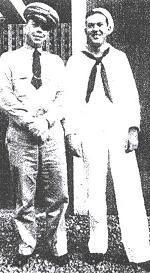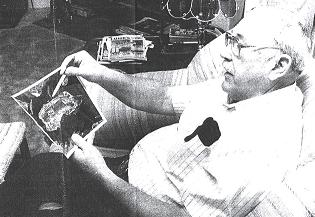Aubrey Gray US Navy Ford Island |
Information provided by Aubrey Gray. |
Aubrey Gray By Elizabeth Cook Pearl Harbor Even those who were born years after December 7, 1941, know at least some of the significance of those two words. It's up there with the Alamo and Valley Forge scenes of conflict and suffering whose remembrance spurs us on when patriotic feelings begin to fade. To Aubrey Gray, it is much more. He was there, and he remembers exactly what he was doing when the first bomb dropped. It's a tale he has told many times. On that morning, 20-year-old Seaman 2nd Class Gray was one of about 40 men getting ready for muster on Ford Island, a small island air station surrounded by Pearl harbor. The island was encircled by docked battleships such as the Arizona, the Utah, the West Virginia and the Raleigh. Gray hadn't been able to get the feel of the harbor yet, having been stationed there only since September. He had spent most of October and part of November in the hospital being treated for an infection he had picked up in Panama, and was just getting into a daily routine. But he had been there long enough to recognize the beauty of the Hawaiian Isles. Ford Island was little more than an island-wide runway, but what lay beyond. "They speak of Hawaiian paradise well, it was," Gray says. "Hawaii before the war was beautiful." Through relations between the US and Japan had steadily worsened over a 10-year period and come to a head that week, Gray said that he was not that conscious of the world situation. "Heck, I was a young kid, I had other things on my mind," he says and his scrapbook photos of native girls and tropical scenes testify. "I thought the US would get in the war in Europe." One out of every four days Gray was on 24-hour duty, and this was one of those days. Muster was supposed to be at 8 o'clock, but for some reason they decided to get it over with early. They made formation inside an airplane hangar. Roll call started, but as Gray recalls, "they never got to my name, so you know they didn't get very far." "I heard what sounded like a plane dive, and then it stopped, so I guessed he had pulled out of the dive. But then there was a tremendous explosion in a hangar right directly across from us. We thought there had been some kind of failurewe broke ranks and went outside to see what had happened." The bombed hangar held a VP22 primarily a long-range patrol squadron. "It was virtually destroyed." "Instantly, we heard quite a number of other explosions. As we were standing out on the concrete runway, we looked up and there was a plane just about 100 feet overhead. Another bomb was dropped nearby, and then a gunner in the plane started firing at the 20 of us, standing right out in the open. "I'm sure if I were to go back there, I'd find pock marks in the pavement from those shots, because dust and rocks flew everywhere. But not one of us was shot." With bombs dropping and gunners shooting everywhere, Gray suddenly was quite conscious of the world situation. "At that point I was certainly aware of what was going onI did what is known as 'getting the heck out of there'." One of two ordinance men with duty on the island, Gray quickly went about the business of handling out guns and ammunition, which were in a hangar. Several cases of machine guns were loaded with dummy rounds, so Gray and the other ordinance man had to reload them all. The attack, which came in two waves, had enlisted men and officers running helter skelter to find some means to defend the harbor. "That was one time when rank was not observes. We all did what we could." Gray and the other man ran over to a small building across the airstrip that contained more ammunition. "We started opening those cases, and since all the electricity was out and there were no windows, we left the door open. "Through that doorway, I had a perfect view of the USS Arizona (it was less than a quarter mile away). Once, when I looked out, I saw a Japanese plane make a shallow dive and drop a bomb that hit just forward of the stack on the ship, right in the magazine. It blew it apartso I happened to see that when they finished the Arizona. Gray also saw the USS Utah, an old target ship, roll over, demolished by Japanese bombers. (The Utah was about 1,100 feet away from him.) It had been 7:55 am in Pearl Harbor when the first Japanese dive bomber arrived over Pearl Harbor. It was followed by almost 200 aircraft, including torpedo planes, bombers and fighters. Shortly after 9 am after a second wave of attack, the Japanese withdrew. Gray says, that was all too long ago for him to feel any bitterness against the Japanese for the surprise attack. When Fuchida came to Salisbury in May of 1964, a born-again evangelist touring the country, Gray and Lee Hill, another Pearl Harbor survivor, had breakfast with him. "I didn't want to show any animosity or recriminations,: Gray said. "I'm not vindictive. A lot of people carry a heavy grudge, but I can'tHe did what he was trained to do. A man in the service doesn't have a choice. It's difficult to hold a grudge against a man under those conditions." For several days after the attack, communications were limited and food was scarce for the survivors. It was at least a week before Gray's family knew he was still alive. But the US soon put its forces into the war full-force, and Gray was transferred to Maui in February of 1942. He was in the Pacific specializing in munitions and bombs throughout most of the war. |
Augrey Gray, (right) poses with Donald Schwartz, who was in Gray's squadron when the seaman first arrived in Pearl Harbor. Photo provided by Aubrey Gray. |

